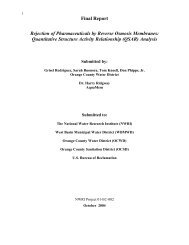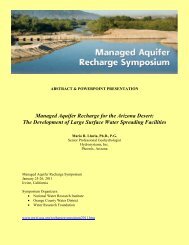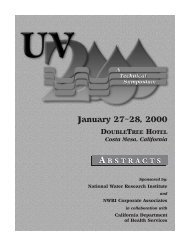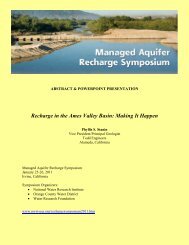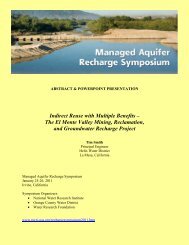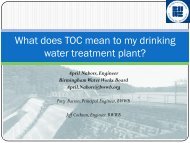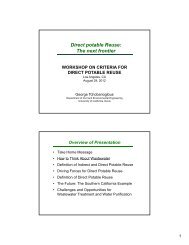RBF_Cover (for eps) - National Water Research Institute
RBF_Cover (for eps) - National Water Research Institute
RBF_Cover (for eps) - National Water Research Institute
You also want an ePaper? Increase the reach of your titles
YUMPU automatically turns print PDFs into web optimized ePapers that Google loves.
18<br />
Riverbank Filtration Suitability<br />
A <strong>RBF</strong> system is designed to infiltrate water from an adjacent surface-water source, using streambed<br />
and riverbank deposits to naturally filter out suspended materials from source water. The first (and<br />
obvious) requirement is that the facilities be placed in close proximity to a source of recharge, such<br />
as a river. During the feasibility and siting stages of a project, a number of criteria must be<br />
considered, including:<br />
• Availability of water from a surface-water source that can recharge the aquifer.<br />
• An efficient hydraulic interconnection between the river and aquifer.<br />
• Suitable water quality in the surface-water source.<br />
• Sustainable flow in the river to match anticipated withdrawal rates.<br />
A detailed hydrogeologic investigation is required to verify that aquifer conditions are favorable<br />
<strong>for</strong> considering a <strong>RBF</strong> facility to meet project water demands. The investigation must evaluate the<br />
geology of the aquifer and the interconnection between the river and groundwater in the aquifer<br />
to determine the feasibility of inducing infiltration from the river, evaluate possible well designs,<br />
and determine likely well yields. This type of investigation typically includes exploratory test<br />
drilling, aquifer (pumping) testing, and data analysis to develop the needed in<strong>for</strong>mation <strong>for</strong> each<br />
prospective project site. Based on the results of this investigation, well designs are developed and<br />
alternatives are compared <strong>for</strong> feasibility, yield, and cost. These alternative designs are generally<br />
discussed below.<br />
Vertical Wells<br />
Vertical wells represent the most conventional method <strong>for</strong> developing a groundwater supply in the<br />
country. These wells consist of a vertical borehole that is usually completed with a screen and riser<br />
casing to allow water to enter from the <strong>for</strong>mation and be pumped from the borehole via a pumping<br />
system installed within the riser casing. A diagram of a typical vertical well constructed in an<br />
unconsolidated (e.g., sand and gravel) aquifer is shown in Figure 2. Vertical wells can be used<br />
effectively when small to moderate yields are needed, or when a system is growing slowly over a<br />
longer period of time, such that adding a well to the system every year or so meets growing water<br />
demands. To meet larger demands, a series of vertical wells must be installed, spreading along<br />
riverfront areas or grouped into well-field clusters.<br />
Vertical wells can be constructed using a variety of drilling methods, including mud rotary, reverse<br />
circulation, cable tool, bucket-auger, dual-rotary, and air rotary. The method selected <strong>for</strong> each site<br />
will take into account a combination of well criteria, including well depths, diameters, water-table<br />
elevations, screen requirements, and potential problems caused by geologic conditions<br />
encountered. These wells are constructed by drilling a vertical borehole, and then installing the<br />
desired well riser casing and screen in the borehole. In some cases, an artificial gravel-pack filter<br />
is also added to help prevent the intrusion of sand and silt from the <strong>for</strong>mation during pumping.<br />
Collector Wells<br />
A collector well, also called a horizontal collector or radial well, differs from a vertical well in that<br />
the well screen is installed horizontally into the aquifer <strong>for</strong>mation from a central rein<strong>for</strong>ced<br />
concrete caisson that serves as the wet well pumping station. These wells are constructed by<br />
sinking sections of rein<strong>for</strong>ced concrete (called lifts) into the aquifer adjacent to the river until the<br />
lower portion of the caisson reaches the design elevation <strong>for</strong> installing the well screen. Individual



